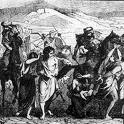
By John D. Baldwin.
Various theories, some of them very wild and irrational, have been advanced to explain the origin of what is seen in these relics of Ancient America. If it had been the fashion to explore and study them as their importance deserves, as Egypt and Nineveh have been explored and studied, our knowledge of them would now be much more extensive and valuable, and it might be possible to go farther toward a solution of the problem they present. But not many persons have sought to explore and understand these remains, and not more than two or three have really sought in earnest to examine the old traditions and books of the country. The abundant inscriptions at Palenque fade in their forest solitude while waiting for the Champollion who shall interpret their mysteries. Something is known, but we have no history of these old cities, no authentic historical record of the people who built them. Therefore theorizing has very naturally been stimulated to great activity, and most of this theorizing has been regulated by the old, unreasoning assumption that civilization found in any place, especially in the olden times, must have been brought and established there as a foreign production. Generally the hypotheses used in this case have presumed as a matter of course that the original civilizers came to this continent from Europe or Asia.
One of these theories is (or was), that the original civilizers of Mexico and Central America were the “lost ten tribes of Israel.” This extremely remarkable explanation of the mystery was devised very early, and it has been persistently defended by some persons, although nothing can be more unwarranted or more absurd. It was put forward by the Spanish monks who first established missions in the country, a class of men to whom the world is indebted for a great variety of amazing contributions to the literature of hagiology; and the same men, in a way equally conclusive, explained the sculptured crosses found in the old ruins by assuming that the Gospel was preached in America by St. Thomas. Lord Kingsborough adopted their views, and gave up nearly the whole of one of his immense volumes on Mexican Antiquities to an elaborate digest of all that had been written to explain and support these absurdities. Others have maintained this Israelitish hypothesis without deeming it necessary to estimate in a reasonable way what was possible to those Israelites.
According to this truly monkish theory, the “lost ten tribes of Israel” left Palestine, Syria, Assyria, or whatever country they dwelt in at the time, traversed the whole extent of Asia, crossed over into America at Behring’s Strait, went down the Pacific coast, and established a wonderful civilization in that part of the continent where the great ruins are found. The kingdom of the ten tribes was destroyed not long previous to the year 700 B.C. How many years are allowed, after their escape from captivity, for this unparalleled journey, has not yet been ascertained. But, if such a journey had been possible, it would have resulted in utter barbarism rather than any notable phase of civilized life. Even the Jews who remained faithful to Moses, although important on account of their scriptures and their religion, were not remarkable for civilization. They were incapable of building their own Temple without aid from the Tyrians. Moreover, there is not any where either a fact, a suggestion, or a circumstance of any kind to show that the “lost ten tribes” ever left the countries of Southwestern Asia, where they dwelt after the destruction of their kingdom. They were “lost” to the Jewish nation because they rebelled, apostatized, and, after their subjugation by the Assyrians in 721 B.C., were to a great extent absorbed by other peoples in that part of Asia. Some of them probably were still in Palestine when Christ appeared. This wild notion, called a theory, scarcely deserves so much attention. It is a lunatic fancy, possible only to men of a certain class, which in our time does not multiply.
*******
This is taken from Ancient America, originally published in 1871.
Disclosure: We are independently owned and the opinions expressed here are our own. We do have advertisements with links to other sites on our pages, and may receive compensation when you click on one of those links and/or purchase something from one of those sites.
Copyright © D. J. McAdam· All Rights Reserved